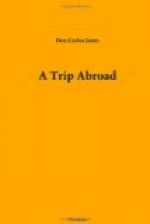The carvings from the palace of Sennacherib, tablets from the library of Asur-Banipal, and brick of Ur-Gur, king of Ur about twenty-five centuries before Christ, attracted my attention, as did also the colossal left arm of a statue of Thotmes III., which measures about nine feet. The Rosetta stone, by which the Egyptian hieroglyphics were translated, and hundreds of other objects were seen. In the mummy-room are embalmed bodies, skeletons, and coffins that were many centuries old when Jesus came to earth, some of them bearing dates as early as 2600 B.C., and in the case of a part of a body found in the third pyramid the date attached is 3633 B.C. Being weary, I sat down, and my note book contains this entry: “1:45 P.M., August 20. Resting here in the midst of mummies and sarcophagi thousands of years old.”
From the top of the Monument I took a bird’s-eye view of the largest of all earthly cities, or at least I looked as far as the smoky atmosphere would permit, and then returned to my stopping place at Twynholm. As I rode back on the top of an omnibus, the houses of one of the Rothschild family and the Duke of Wellington were pointed out. My sight-seeing in Scotland and England was now at an end, and the journey so far had been very enjoyable and highly profitable. I packed up and went down to Harwich, on the English Channel, where I embarked on the Cambridge for Antwerp, in Belgium. In this chapter I have purposely omitted reference to my association with the churches, as that will come up for consideration in another chapter.
CHAPTER II.
Crossing Europe.
Immediately after my arrival in Antwerp I left for a short trip over the border to Rosendaal, Holland, where I saw but little more than brick-houses, tile roofs, and wooden shoes. I then returned to Antwerp, and went on to Brussels, the capital of Belgium. The battlefield of Waterloo is about nine and a half miles from Brussels, and I had an enjoyable trip to this notable place. The field is farming land, and now under cultivation. The chief object of interest is the Lion Mound, an artificial hill surmounted by the figure of a large lion. The mound is ascended by about two hundred and twenty-three steps, and from its summit one has a good view of the place where the great Napoleon met his defeat on the fifteenth of June, 1815. There is another monument on the field, which, though quite small and not at all beautiful, contains an impressive inscription. It was raised in memory of Alexander Gordon, an aide to the Duke of Wellington, and has the following words carved on one side: “A disconsolate sister and five surviving brothers have erected this simple memorial to the object of their tenderest affection.”




